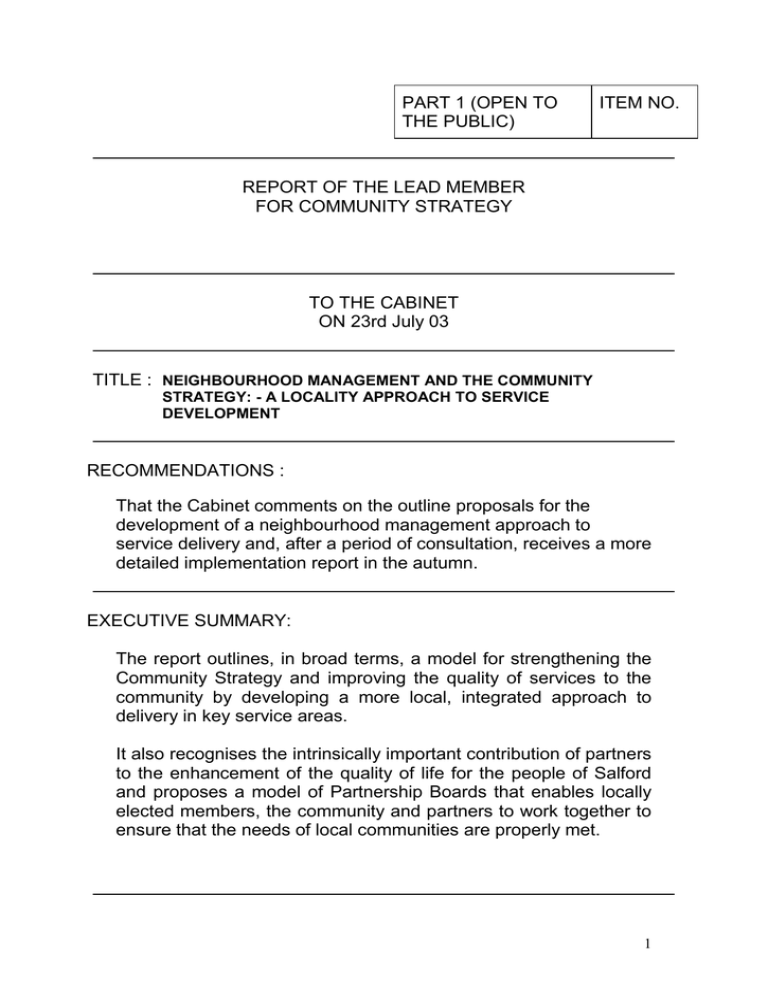PART 1 (OPEN TO ITEM NO. THE PUBLIC)
advertisement

PART 1 (OPEN TO THE PUBLIC) ITEM NO. REPORT OF THE LEAD MEMBER FOR COMMUNITY STRATEGY TO THE CABINET ON 23rd July 03 TITLE : NEIGHBOURHOOD MANAGEMENT AND THE COMMUNITY STRATEGY: - A LOCALITY APPROACH TO SERVICE DEVELOPMENT RECOMMENDATIONS : That the Cabinet comments on the outline proposals for the development of a neighbourhood management approach to service delivery and, after a period of consultation, receives a more detailed implementation report in the autumn. EXECUTIVE SUMMARY: The report outlines, in broad terms, a model for strengthening the Community Strategy and improving the quality of services to the community by developing a more local, integrated approach to delivery in key service areas. It also recognises the intrinsically important contribution of partners to the enhancement of the quality of life for the people of Salford and proposes a model of Partnership Boards that enables locally elected members, the community and partners to work together to ensure that the needs of local communities are properly met. 1 BACKGROUND DOCUMENTS : (Available for public inspection) Cabinet Papers: July 2000, “Building on success – a review of Community Strategy” April 2002, “The Community Strategy – Key issues”. January 03, “Developing Community Action Plans and the Community Strategy”. ASSESSMENT OF RISK The report addresses the difficulties in achieving the aspirations of the Community Strategy and the need to ensure that all stakeholders are committed to the changes proposed. THE SOURCE OF FUNDING IS Resource implications to be identified in more detailed report to be presented to the Cabinet LEGAL ADVICE OBTAINED Legal advice not sought at this stage. FINANCIAL ADVICE OBTAINED Not applicable CONTACT OFFICER : 2 Tom McDonald, Assistant Director (Community Strategy) Community & Social Services Directorate WARD(S) TO WHICH REPORT RELATE(S) All wards KEY COUNCIL POLICIES Community Strategy 3 1. PURPOSE OF THE REPORT The Community Strategy was introduced 8 years ago and Salford has been at the forefront of pioneering ways in which to improve local service delivery and engage with communities. The City now has a well-established structure of Community Committees which each produce a local plan and which have shown, particularly through the use of devolved budgets, a capacity to commission services that reflect local need, strengthen community groups and support capacity building. Nevertheless, the Community Strategy has the capacity to develop further and to provide a vehicle for improved, integrated service delivery that will result in a better quality of life for the people of Salford. This consultation paper sets out proposals, therefore, to take the Community Strategy to its next stage of development. It focuses on two key areas: Developing a neighbourhood management approach to service delivery within Community Committee areas by focussing on those services that are the priorities for local people. Strengthening of the role of elected members as community leaders and working with local people and partners through local partnership boards to drive the agenda within their communities. 2. INTRODUCTION This paper develops a model for future work, first outlined in a report to Cabinet in December 02. Neighbourhood management is a term that has different meaning to different people. There are currently a number of pilot neighbourhood management programmes, sponsored by the ODPM. However, those pilots focus on communities of 8,000 to 15,000 populations. This is not the model proposed in this paper, which seeks to build on the basic structures of our Community Committee areas, which serve larger populations and which have increasingly become the vehicle for service delivery used not only by the Council but also its partners. Nor is it the model of neighbourhood management tested in areas such as Walsall or Tower Hamlets, which involved across-the-board devolution of services to small populations. Rather, the model proposed is one that builds on the experience that the City and its partners have gained through the Community Strategy, focusing on services where they are being or have the potential to be delivered more effectively by having a stronger geographical and neighbourhood perspective. It is an evolutionary model, therefore, with the potential for future developments, informed by the experience of partners and Directorates. Nor does the model seek to compromise any partners’ or Directorates’ ability to deliver local or national targets or to provide cost efficient services. The achievement of these goals remains a priority. Rather the intention is to focus on those services whose delivery and quality can be enhanced by developing a more integrated and stronger neighbourhood focus. 4 The paper does not seek at this stage to provide all of the detail on every aspect of how the model might work. Rather, it seeks to outline, in broad terms, a model that will strengthen and improve the delivery of integrated services to communities. The detail must be developed through consultation across the City and with partners in order to ensure that the model is rooted in the experience of and has ownership by as wide a constituency as possible. The paper does not make any recommendations in respect of community capacity building or engaging local people in developing a neighbourhood management approach. Whilst engagement of local people is fundamentally important to developing this approach, the Best Value Review of Community Engagement, currently underway, will make recommendations that must inform the model outlined in this paper. 3. OBJECTIVE The overall aim is to create a vehicle for improved delivery of services that will enhance the quality of life for people in their communities by: Creating the post of Neighbourhood Manager in every Community Committee area. Creating a neighbourhood management team, with identified leads for key service areas that the community regards as most important for determining its quality of life: o Crime o Environmental maintenance o Young people o Housing and regeneration Improving access to and the quality of services through a more integrated approach to service delivery at a neighbourhood level. Engaging the community in service development. The establishment of a local partnership board to drive these developments. The measure of success will be improved access to services by communities with increased satisfaction rates and the development of new and improved services. Achievement of this objective will require the input of not only City Council Directorates but also of other partners, particularly the police and the PCT. Both organisations have already demonstrated significant commitment to the Community Strategy and are currently reconfiguring their services to enhance their capacity to work within a multi-agency context and working more closely with communities and Community Committee processes. 5 4. FRAMEWORK The proposal builds on the framework of the Community Committee structure because that is the framework that the City Council and, increasingly, its partners have accepted as its basic structure for service delivery. Its strength is that it provides mechanisms for the involvement of local people and, therefore, is a framework that can be developed further to achieve the goals of the programme. There will, however, be issues to be clarified in the development of the model regarding the relationship between the Community Committees and the Area Based Initiatives (AIBs) in Seedley/Langworthy (SRB) and in Kersal/Charlestown (NDC). 5. PRINCIPLES In order to achieve the overall aim of the model, the following principles should underpin its development. Wherever possible, services should be joined up across the partnership at a local level. Directorates and partners should maximise the opportunities, created by more integrated approach, to develop new services that are more responsive to local need. The achievement of national and local targets will remain a service priority. However, opportunities should be constantly explored as to how effective delivery of services at a local level will help to achieve national and local targets. Service providers should engage with the community to ensure that they are meeting local need. Management arrangements should be characterised by strong leadership from Directorates and Partners, with clarity about overall service objectives and frameworks, whilst maximising the opportunities for devolution of decision-making, creativity in service delivery and responsiveness at a local level. City Council Directorates and Partners should be willing to pool resources in order to achieve more efficient and effective service delivery. 6. DEVELOPING A NEIGHBOURHOOD MANAGEMENT APPROACH TO INTEGRATED LOCAL SERVICE DELIVERY Within each of the service areas identified, - crime, environmental maintenance, young people and housing/regeneration, - significant steps have already been taken to strengthen their geographical perspective and responsiveness to local communities. Discussions have begun on how that might be developed further. 6 Crime Improved service delivery around crime can build on the work that has already been established between the police, the City Council and other partners in the development of the sector team model. At the core of the process are a sector sergeant, principal officer (Community Safety) and the Neighbourhood Co-ordinator who coordinate a strategic response to local crime issues as well as ensuring an action-oriented approach towards individuals at risk or involved in anti-social behaviour. Discussions have already begun on how other services, for example, community liaison and anti-social behaviour services, could be improved by being incorporated into a more locally based service delivery model. A police priority is to work more closely with communities and they are planning to implement changes to support a stronger geographical perspective to their work by Autumn 03. Thus, the police are very supportive of a model that seeks to develop further a more integrated approach across a range of services to improve delivery at a community level. Environmental services Environmental services encompass a broad range of services, many of which would not lend themselves to a local delivery model. However, local people place great priority on street cleansing, removal of refuse and environmental maintenance. These services also overlap with issues relating to crime, regeneration and to young people. The Environmental Services Directorate have already taken significant steps moved towards a more localised approach to street cleansing and environmental maintenance services through the appointment of environmental coordinators who take an overview of cleansing and environmental issues in Community Committee areas. Similarly, the Green Directory has given Community Committees a degree of choice in determining local priorities for environmental maintenance. The model seeks, therefore, to build on these developments and strengthen service delivery through a more integrated approach with other related services operating within Community Committee areas. Services for young people All Community Committees identify services for young people as a priority. During the past two years and facilitated by devolved budgets, local models of work with young people have developed using a range of inputs, including sports, arts and youth work that have begun to have significant local impact. This work has included support to voluntary and community organisations working with young people and has provided a basis for incorporating other initiatives, such as SPLASH and summer activity programmes, based in Community Committee areas. 7 The LEA has indicated that it wishes to build on this model and move towards the appointment of a coordinator who would be a link with each Community Committee area to develop an integrated approach across arts, youth and sports that would also make the connection with other over-lapping, local agendas. However, the biggest challenge to developing a more localised model is the low level of core resources in sports, arts and youth work which might impact on the capacity of the service to support the development of the model to the degree that it would wish and is desirable. These issues will be explored in further discussions. Regeneration/Housing services The City is about to embark on a major regeneration programme through HMRF that will transform the physical appearance of Central Salford. The City is also seeking other resources to develop and sustain other communities in the west part of the City. In order for regeneration programmes to be successful, a range of other programmes must accompany them to strengthen and revitalise communities. The teams that are created to develop this radical transformation of the City’s physical appearance must be integrated, therefore, with other locally based services that address social and other needs in order, therefore, to maximise the potential of the programmes and to ensure that local people are at the heart of the developments. Health The PCT has embarked on significant changes that build on and support the aims of the Community Strategy. First, the creation of four localities for delivery of health services that will follow Community Committee boundaries with the overall aim of developing decentralised and more communityfocussed services. Second, within the locality programme, the development of public health teams to work alongside other locally based staff across agencies and Directorates to begin to tackle the significant health inequalities agenda in the City. This is a crosscutting agenda that can support and benefit from the neighbourhood management model outlined in this paper. 7. MANAGEMENT ARRANGEMENTS In order to ensure that these services can be developed in an integrated and coordinated way, it is proposed that a Neighbourhood Manager should have responsibility for the coordination of day-to-day activity in the Community Committee area. The Neighbourhood Manager will coordinate activity through the lead person for each of the service areas identified. Thus there will be a team of managers of the key services working with the Neighbourhood Manager, who will develop an integrated approach to service delivery in the Community 8 Committee. Future work will need to clarify the implications of the model for the posts of Neighbourhood Co-ordinator The model will require a different and a more complex set of management arrangements that reflect more the developments in new and joint services such as the Youth Offending Team or Learning Disability services. They are multi-agency services where day-to-day decisions are taken at a local level whilst professional support, training and overall strategy remain the responsibility of the home Directorate or Service. Clarification of management arrangements and accountabilities will be a key issue in future discussions. 8. PARTNERSHIP BOARDS As this paper has illustrated, key partner agencies, the police and the PCT, have adopted the Community Strategy as the vehicle through which they believe that they can fulfil their responsibilities more effectively. There is potential for developing further inter-agency work, for example, through pooling of resources at a local level to improve the services received by communities. At the present time, the governance arrangements for Community Committees do not allow or support such developments and, therefore, opportunities for the strengthening of partnership work and integrated service delivery may not be fully realised. Importantly, the model outlined in this paper provides an opportunity for locally elected members to fulfil their role as community leaders through partnership arrangements at a local level to ensure that there is an holistic view adopted across agencies to meeting the needs of local communities. Whilst the political executives provide a forum for local elected members to oversee the performance of council services, it is proposed that there is also within each Community Committee area an executive group or Partnership Board with the responsibility for overseeing the strategic co-ordination of local services. Such a grouping would be made up of elected members, representatives of the Community Committee and key partner agencies. Further discussion and legal advice will be required to develop more detailed proposals, should Cabinet agree that these ideas should be pursued further. More detailed discussion would also include the relationship between the executive group or partnership board and the Community Committee and accountability arrangements. 9. CONCLUSION This paper attempts to outline, in broad terms, a model for the further development of locally based, integrated and responsive services that strengthen partnership work and the role of elected members. 9 It builds on the expertise of services and developments that have already taken place whilst introducing significant changes in service delivery to improve the quality of key services to local communities. Cabinet is asked to agree the broad outline within this paper and, if approved, to receive a more detailed report in the autumn on the details of implementation and its implications. Tom McDonald Assistant Director (Community Strategy) 9th July 03 10






